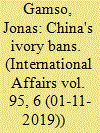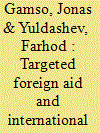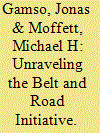|
|
|
Sort Order |
|
|
|
Items / Page
|
|
|
|
|
|
|
| Srl | Item |
| 1 |
ID:
170401


|
|
|
|
|
| Summary/Abstract |
China has been a major market for elephant ivory for centuries. However, the Chinese government recently enacted bans on imports and exports of ivory (2015) and on the domestic ivory trade (2017). These bans appear to have come in response to intensive influence campaigns and public shaming from domestic and foreign activists, who cited declining elephant populations and highlighted China's role. However, this shaming-narrative is at odds with conventional wisdom regarding Chinese policy-making: China typically resists international pressures and its authoritarian government is thought to be largely insulated from domestic efforts by civil society groups. This article reconciles Beijing's ivory policy with these conventional beliefs about policy-making in China. I argue that the Chinese government saw unique benefits to banning the ivory trade, under growing international scrutiny, as doing so enhanced Chinese soft power while having very little impact on its sovereignty or development. Non-government organizations (NGOs) operating both inside and outside of China played a role as well: NGOs in China helped to shift Chinese public opinion towards favouring the bans, while those operating abroad led public relations efforts to publicize Chinese demand for ivory to foreign audiences. Efforts by the latter group of NGOs intensified pressure on the Chinese government to rein in the ivory market, while increasing the soft power benefits that banning ivory would bring to Beijing.
|
|
|
|
|
|
|
|
|
|
|
|
|
|
|
|
| 2 |
ID:
163277


|
|
|
|
|
| Summary/Abstract |
Faced with the failure of traditional immigration controls, policymakers in the United States and Western Europe increasingly look to foreign aid to reduce migrant inflows. Some analysts expect assistance to improve living standards in source countries, thereby deterring residents from moving abroad. While this idea makes intuitive sense, research on aid and migration shows mixed results: some scholarly work supports aid-based migration policies, but other analyses suggest that aid actually enables migration by providing individuals with resources that facilitate movement across borders. We suggest that this tension in the literature reflects a failure to distinguish between different types of foreign aid. Drawing on recent work demonstrating the heterogeneous effects of various aid projects, we posit that governance aid should deter emigration by enhancing government capacity and alleviating political push factors; in contrast, economic and social aid should enable migration by increasing individuals’ means and capabilities to move. We test our hypotheses on a panel of 101 developing countries spanning twenty-five years (1985–2010). We find that governance aid does reduce emigration rates from developing countries, while other types of aid appear not to affect migration.
|
|
|
|
|
|
|
|
|
|
|
|
|
|
|
|
| 3 |
ID:
189313


|
|
|
|
|
| Summary/Abstract |
Scholars and analysts have sought to clarify the Chinese Communist Party’s motives for carrying out the Belt and Road Initiative (BRI), a series of infrastructure investments in countries across the globe. While many emphasize Beijing’s geopolitical interests, this paper argues that the BRI should also be understood as a large-scale effort to create business activities for Chinese companies and workers outside of China. We define the contours of this “building out” strategy by analyzing the stages that typify BRI projects: project selection, project financing, project construction, and post-construction operation and management. Our analysis draws, in large part, on data that we have compiled from a sample of BRI projects. After showing macro-level trends in the data, we offer three in-depth case studies to clarify the underlying mechanisms at work. Our findings suggest that BRI projects are engineered to direct finance and construction bids to Chinese companies, which are typically state-owned.
|
|
|
|
|
|
|
|
|
|
|
|
|
|
|
|
|
|
|
|
|